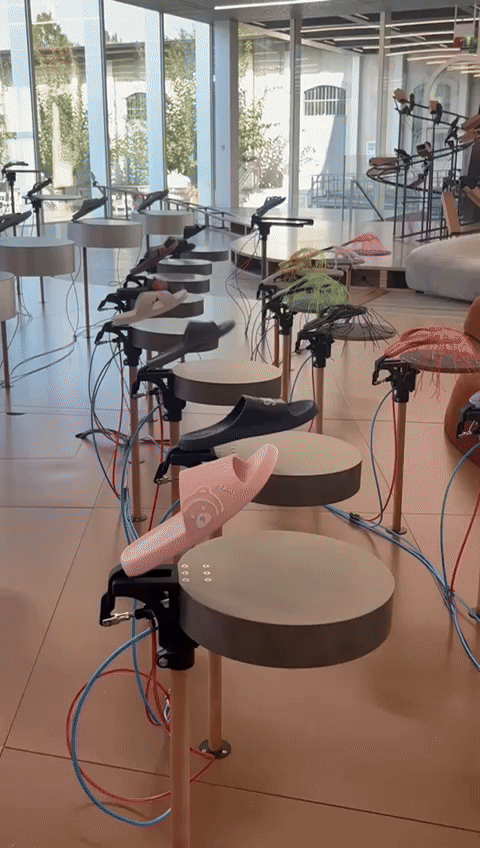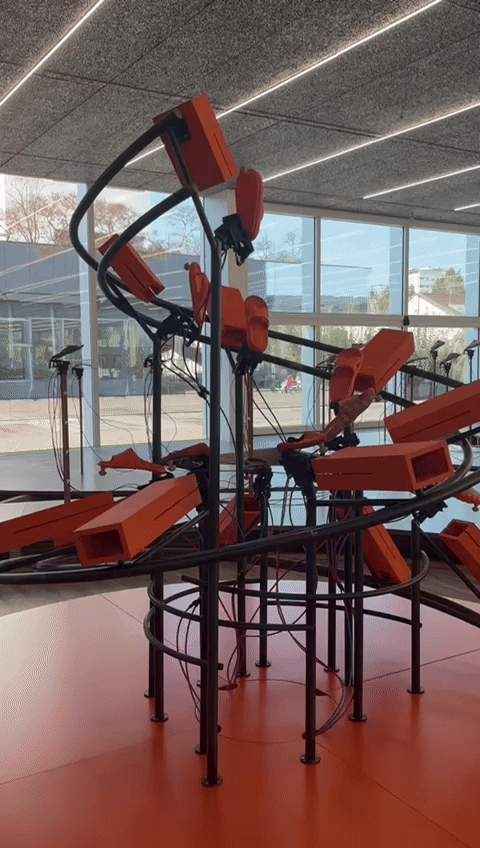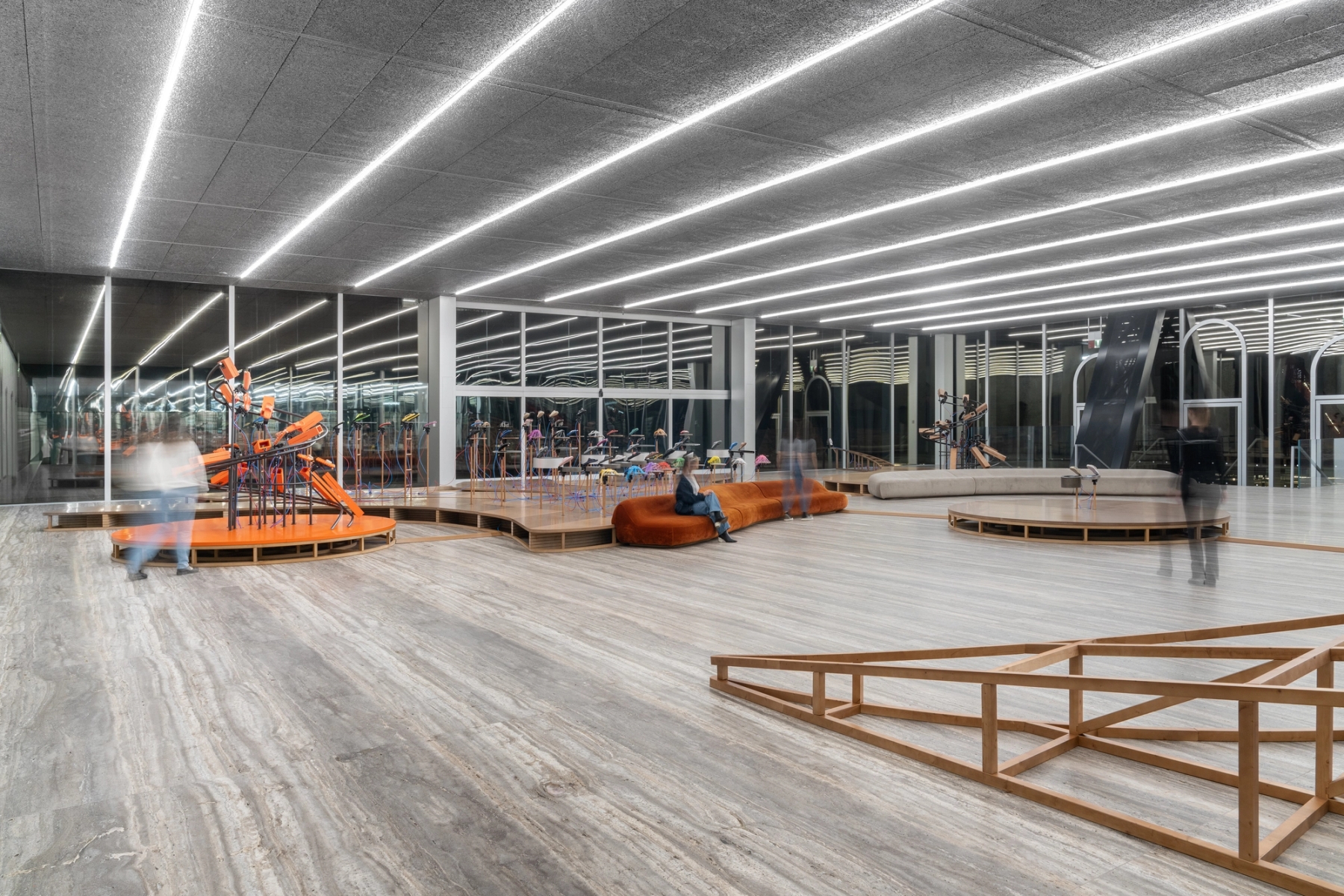Cheb Runner, composer of Meriem Bennani’s Sole Crushing
Words: Annalise June Kamegawa
Opening reportage: Martha Kirszenbaum
Exhibition views: Delfino Sisto Legnani – DSL Studio - Courtesy Fondazione Prada
Meriem Bennani’s “For My Best Family” is a playful, heartfelt expansion to Fondazione Prada’s glamorous cultural sphere. Featuring pneumatically powered flip-flops, a jackal-bear romance, and the voices of her loved ones, Bennani’s work is both imaginative and grounded. Alongside the animated film, “For Aicha,” her Milan exhibition includes the sound installation, “Sole Crushing,” composed by music producer, Cheb Runner (Reda Senhaji).

Novembre spoke to Cheb Runner (Reda Senhaji) on his practice and working with flip-flops to compose Meriem Bennani’s recent installation, “Sole Crushing.” The sound installation is part of her exhibition “For My Best Family,” on view at Fondazione Prada Milano from 31 October 2024 – 24 February 2025.



Blending Western European electronic music and traditional Moroccan and North African sounds, the Brussels/Rotterdam-based artist is marked by an ever-evolving, experimental style that reflects his history and advocacy for diasporic communities.
His work also coincides with his contribution to the (A)WAKE collective – a group he works with alongside his partner, Shirin Mirachor, to facilitate cultural exchange between WANA (West Asia and North Africa) and Western Europe.

You had mentioned that you had first met Meriem Bennani when she was exhibiting "Cursed Objects" at C L E A R I N G in Brussels. So, is “Sole Crushing” your first foray into the world of contemporary art?
In terms of “contemporary art," I had found myself doing this-or-that collaboration. So maybe indirectly, I was already “in”. But now, because of this collaboration with Meriem, it's become really visible. I got to go super deep and gain accessibility to this DIY-type of project [“Sole Crushing”] that that we couldn’t release in normal life. But it worked with this kind of finesse and design that Fondazione Prada applied to the project.

When Bennani told you that sandals would be at the center of “Sole Crushing”, how did you begin the process of exploring their potential as musical instruments?
Back in 2022/2023, I performed for the after-party of Meriem's C L E A R I N G gallery show, as a DJ. During the day we met at North Brussels Station. At that point, I think she was already working on “Sole Crushing.” She brought these flip flops, but we didn’t end up talking about that. We ended up talking about how I liked automation and making Chaabi (Moroccan rhythms). She responded, “Yeah, I actually have this idea already! Let’s make it happen.”



After having a call with Fondazione Prada [about “For My Best Family”], I started the composition process by filming on my phone. I made five videos of five flip flops on five different surfaces and created a traditional rhythm with them. This sequence was a kind of simulation.
With the engineers and the team, we had about three or four days of experimentation in the manufacturing of the system. There, it actually became visible.
As we set up, I started making loops and then proceeded to make music with that. I looked up and was like, “wow, that's fucking working!”
By the end of the first day of this experimentation, the engineer and I hugged each other. He was super happy to see his system up and making a rhythm.
That was one of my highest moments with the work.



Like most exhibition spaces, Fondazione Prada’s Podium, where “Sole Crushing” is installed, is more or less a blank box (stone floors, glass walls, etc.). Could you talk about some of the technical challenges in working within the acoustic constraints of this space?
We had three technical challenges: The first one is latency. For example, it’s like hitting a note on the keyboard. That translates the signal to the system. To get the note to the microcontrollers of the whole “Sole Crushing” installation, it takes a few milliseconds. I had to work through that the first few days.
The second was delays. When one of the flip flops makes a sound, that sound hits against the different walls and spaces, and it comes back to you with a delay. Basically, I had to adapt to it myself by composing to the microsecond and sometimes working live.
The third was the compressed air that gives the sandals power to make mechanical movements. That was also something that we had to consider when thinking about communication throughout the whole system.

When talking about the installation, Bennani had remarked on the flip flop as “the lowest object in the fashion chain.” After working so much with them, how has your relationship to the flip flop object changed?
When Meriem came to me with this proposal, I was already familiar with the sandal, you know. It was in daily use for us! My grandma, my mom, my aunt, and the whole family, used them... So, I laughed and was like, “wow, nice, we’re finally going to get to use the flip flops.”
They were often thrown at us by family members, sometimes in anger—or sometimes even without a particular reason. When somebody throws something at you, you always hear it. I remember when you don’t get hit as the target, the flip flop ends up hitting the door, and it makes this big sound.
It was fun to use that as an object to transmit the rhythm. It gives more value and more power to the installation.
In the end, the flip flop is a really powerful object.
In terms of this concept, Meriem has really strong artistic ideas and I trusted her sense for it.



You, like Bennani, are also Moroccan. She had mentioned that working with someone from the same background was important to her when developing this work. I’m interested in how that common cultural background informed the piece, especially in recreating of traditional Moroccan instruments.
We wanted to make something like Moroccan instruments, but those instruments are made to be played by human beings. They were adapted to our hands and our organs. In the end, we had to find a way to make flip flops themselves into a type of instrument.
We could take normal musical instruments and have flip flops play them, but it wouldn’t have sounded better. We had to find some acoustically interesting system that, when in contact with flip flops, could create powerful sounds.
Meriem and I were experimenting with the with the technicians… Can we loosen something a little bit to make the surface move? When the flip flop hits, does the surface vibrate enough?
With all this, we ended up having something that really sounded like a darbuka drum, not just an imitation of a darbuka made from flip flops.
You’ve now been based in the EU (Rotterdam & Brussels) for quite some time now. How has this migration shaped your musical and artistic practice?
I moved from Morocco to Brussels around 2012 when I was 19 years old. Basically, I came to study engineering. As a young Moroccan, it was a knowledge migration. Let’s say it was also a curiosity migration. That’s how I ended up here, but I found myself in a completely different space.
When you immigrate somewhere, there are some decisions (economic, social, etc.) you have to make. And I ended up making music.
It was super interesting for me because it was like, why not develop that? I had this image: How can I stay in connected to my roots and where I came from while also making a new kind of music? It’s great to experiment and create something that joins people who have different approaches, come from around the region, or are part of the diaspora.
I am now recording instruments to make an archive of rhythmic signatures - a kind of sound bank. I started in Morocco with street musicians. Often, you’re just walking through the streets of Agadir, of Marrakech, of Casablanca, and there’s a musician playing. I try to record that, not to use as samples for my work, but more to archive it. If I end up wanting to use it, I try to make a fair payment, then work to form a good relationship with the musician. So it's sampling, but not sampling the rhythms themselves; rather, it's the instruments.
I try to share it with people – this new generation of producers and people that need it to develop this genre of music. I go from Egypt, from Algeria, from Tunisia, Lebanon, Palestine, Saudi Arabia, Iraq to dig really deep into something that we don't hear often. It’s instruments and sounds unfamiliar to our ears, especially the percussions.
In Rotterdam, I started my relationship with my partner, Shirin Mirachor, the director of (A)WAKE. It’s a movement that she created back in 2019 that I became a part of. In Morocco and other countries like Tunisia, we work to create a bridge between the diaspora, migration, and the country. We work on how to communicate, collaborate, and make exchanges in a fair way.


If you could recommend three musical artists from the past we should all be listening to, and three contemporary artists you see shaping the current sound, who would they be?
Okay, that's really hard because I like lot of musicians… I don't want to give a specific shout out! I find it super hard to say, “this is the best.” In reality, all of them are the best at what they’re doing. Can I send them to you later?
[These are Cheb Runner’s recs: Warda, Maalem Mahmoud Guinia, Joe Zawinul (from the past). Aita Mon Amour, Karim Ziad, Deena Abdelwahed (shaping the current sound).
What’s next after “For My Best Family?”
I'm now working on an EP about ‘90s music. How could we imagine living in the 90s and making Moroccan music? How can I make it like techno-house music, jungle, with rhythms that are influenced by region?
The modular is really based on polyrhythmic, synthesis, and micro-tunings. It's trying to explore these two sides of nonconforming western music. It comes down to how adapt technological devices to traditional and folkloric music.
And then I don't know with Meriem. I have the feeling that there will be new things after “For My Best Family”. I don't know when, but for sure, there will be funny things to come.

It seems everything she makes is pretty funny in nature.
That’s cultural! We're serious, but in a funny way. It's nice to get to capture that moment.
That's how we keep working hard without being too worried. It's just not too heavy for us. It can be just joy. That's the most important thing.

Online: https://chebrunner.world/
collective: (A)WAKE

